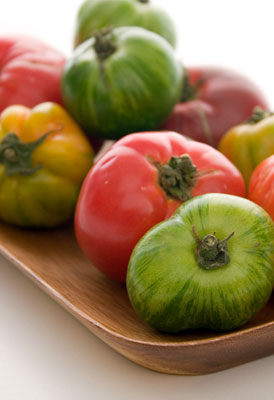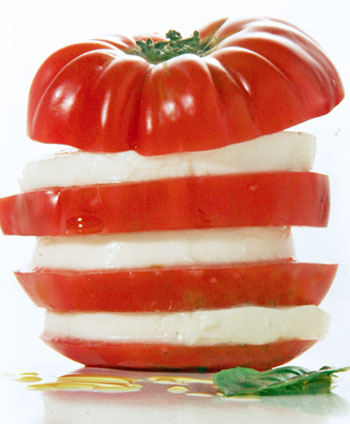 With no attempts to revise biblical history, I have concluded that some religious scholars may have erred. I simply do not believe that the fruit hanging from the Tree of Knowledge in the Garden of Eden could have ever been an apple. In my humble opinion there is only one fruit that had the potential to misdirect Eve into morally unsound behavior.
With no attempts to revise biblical history, I have concluded that some religious scholars may have erred. I simply do not believe that the fruit hanging from the Tree of Knowledge in the Garden of Eden could have ever been an apple. In my humble opinion there is only one fruit that had the potential to misdirect Eve into morally unsound behavior.
It had to be an heirloom tomato.
Alright, it’s not as romantic and symbolic as the ubiquitous apple and what I’ve written may be considered blasphemy, but when you take that bite of your season’s first heirloom tomato you quickly understand how some things on this planet can just be absolutely perfect as they are and make you want to do bad, bad things just to get another bite.
It might just make you want to write a letter to the editor of the Good Book. Wait, um, on second thought, scratch that.
Heirloom tomatoes have gained popularity in the past decade or so, and that puts one of the biggest smiles on my face. If you’ve never tasted an heirloom (let alone never seen one), you might react by shock and horror and then pure idiotic delight. Simply put, heirlooms are very very old tomatoes, grown from plants and seeds that have been handed down from generation to generation. Because of their lineage, there’s usually a story behind each specific variety.
Black Krim hail from the Soviet Union, Brandywines come from Amish farmers in the Eastern United States. These hard-to-grow tomatoes are not your everyday supermarket variety; in fact, many of the mass-produced tomatoes have been genetically engineered to last longer, possess thicker skins, and to ripen and grow at the same time. Sad but true – the tomatoes most of us eat everyday are a result of industrial agriculture and don’t even come close to the treasures of an heirloom.
So, what’s the big deal? Aside from the price, how good can it taste? It’s just a tomato, ain’t it?
That’s what I used to think. I should fully disclose that I’m not a big veggie lover and never really have been, but about 12 years ago something changed my mind. It was a stroll through a farmer’s market here in California when I noticed the warbled, knotted, striped and malformed shapes of heirloom tomatoes and thought “now that’s about the ugliest tomato I’ve ever seen.” I picked up a big one, noticed how different its skin felt and smelled a fragrance that was like no other tomato I’ve ever encountered. I took them home, sliced them and my seasonal love affair began.
 Heirlooms are juicy, sweet and succulent, with flavors ranging from tart to full-on fruit. They have the texture of what you think a tomato should feel like, and their acidity makes them a delight to eat as is. One of the toughest parts of my job is this time of year, when cases upon cases of heirlooms are handed to me to taste, photograph, test and research, and every year I tell myself I will not tolerate the abuse again–wink wink.
Heirlooms are juicy, sweet and succulent, with flavors ranging from tart to full-on fruit. They have the texture of what you think a tomato should feel like, and their acidity makes them a delight to eat as is. One of the toughest parts of my job is this time of year, when cases upon cases of heirlooms are handed to me to taste, photograph, test and research, and every year I tell myself I will not tolerate the abuse again–wink wink.
Because of this and the surplus tomatoes, I’ve experimented with heirlooms in ways I’ve never dreamed of (or in ways I could never afford.) Pasta sauces, tarts, soups, sorbet, if it can be done I did it. And you know what? I’d never do it again to my beloved friend.
Lest you think I’m a dullard, heirlooms are best enjoyed in their most natural state, unadorned and unfussed with. Sliced, drizzled with a high quality full-flavored olive oil and sprinkled with sea salt, it’s often the simple things that taste best. That’s not to say you can’t make an amazing Caprese salad with heirlooms or enjoy them with prosciutto, because you can. And you should. But you’ll probably only end up disappointing yourself if you decide to make a pasta sauce out of these delicate beauties. I just don’t think it works.
Now if you’ll excuse me, I have about 3 lbs of tomatoes I must devour before they go bad (these delicate beauties don’t last long), and when I’m done I’m placing a call to the Vatican about that bible intro. Wish me luck.
If you want a cool, no-cook recipe that lets the tomatoes shine without burying them in unnecessary flavors and ingredients, you gotta try this soup.
Heirloom Tomato & Fennel Soup
Ingredients:
2 cups cubed bread, crusts removed
(cut into 1/4-inch cubes)
1 clove garlic
3 tablespoons chopped red onion
2 lbs assorted heirloom tomatoes, chopped
1/2 cup chopped fennel
1 tablespoon champagne vinegar
1/4 cup extra virgin olive oil
juice of half a lemon
dash of paprika
1/4 teaspoon ground cumin
1 cup ice water
sea salt
Method:
Place the cubed bread in a bowl and add enough water to cover it. Let it stand for at least 20 minutes to soften completely. Once softened, squeeze excess water from the bread and place in a blender with the garlic, onion, tomatoes and chopped fennel. Purée until smooth, then add lemon juice, vinegar, cumin and paprika and 1 teaspoon of salt. Purée again, and add the olive oil and ice water while the motor runs. Do this in batches, if needed, depending on the size of the blender. Chill well.
Before serving, stir the purée through a fine mesh strainer if you’d like a smooth soup. Top with minced fennel fronds and season with salt and pepper, to taste.
-- Also published on MattBites.com

